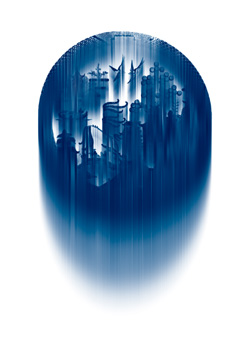Mobile Structures: Dialogues Between Ceramics and Architecture in Canadian Art
27 January 2007 – 13 May 2007

Rory MacDonald Blue Flow (willow pattern) digital print, 2006
Organized by the MacKenzie Art Gallery with the support of the Canada Council for the Arts, the Saskatchewan Arts Board, and the City ofRegina Arts Commission.
The connection between ceramics and architecture has a rich history, but a bleak present. Consider the distinctive blue and white lines of “Old Willow” pottery. For over two hundred years, this familiar ware has encouraged dawdling children to forget their porridge and enter an imaginative landscape marked by an oddly arched bridge, a pagoda-like tea house and a strangely stylized willow tree. For centuries, architectural scenes, whether buildings or gardens, were common subjects for ceramics and spoke of the close connection between pottery, hearth and home. Mel Mac, Corel and contemporary industrial ceramics can hardly claim this lineage.
Think also of the place of ceramic ornamentation on buildings. In Regina we have a wealth of examples ranging from the fantastic Egyptian designs on the Albert MemorialBridge to the classical foliage adorning the old SGI building. Glass, steel and plastic have largely replaced this material and its iconographic bounty.
Mobile Structures investigates recent ceramic practices which seek to re-establish a dialogue with architecture in the creation of new senses of space, dwelling, identity, body and nature. The nine artists in the exhibition, selected from across Canada, provide intriguing examples of how ceramics responds to architectural ideas and how architecture might respond in return.
Taking as a starting point ideas developed by Vancouver critic Amy Gogarty, the exhibition examines the potential of ceramics to challenge the fixed qualities of architecture by creating “mobile structures,” both literally and metaphorically. As in the case of “Old Willow” ceramics, architectural images and ideas have travelled around the world on tiles and pottery. Rory MacDonald’s ceramic graffiti using the “Old Willow” pattern, Jeannie Mah’s references to Iznik tiles, and Alwyn O’Brien’s multi-decalled pots carry a wide range of mobile architectural references.
And, like the Albert Memorial Bridge, ceramic architectural ornamentation allows fixed structures to incorporate imaginative elements that transform how we see them. Gilbert Poissant’s handprint wall mural, Greg Forrest’s coral-like screens, and Ruth Chamber’s hanging porcelain arches point to the architectural possibilities created by the reintroduction of ceramic ornament.
In other works, ceramic installations behave like architecture itself, transforming how we conceive of built space. Jeremy Hatch’s life-size porcelain tree fort, Linda Sormin’s “ungrounded” tower of linked
ceramic elements, and Christian Bernard Singer’s formal French garden maze each involve the viewer in a reconsideration of architecture’s basic language.
Mobile Structures is a site of investigation for the future of ceramics and architecture as connected or intersecting disciplines. With three prominent artists from Regina included in the exhibition — Jeannie Mah, Rory MacDonald and Ruth Chambers — it is also an opportunity to consider the ongoing legacy of ceramics in the region, a history which was recently explored in the MacKenzie exhibition, Regina Clay: Worlds in the Making. Fittingly, the opening of Mobile Structures will coincide with the official launch of the Virtual Museum of Canada web site for Regina Clay, a major undertaking which will extend access to this history to a global audience.
Image Credit:
Rory MacDonald
Blue Flow (willow pattern)
digital print, 2006
acrylic on panel
Collection of the artist.
Events
-
![Three figures march through the winter snow carrying a transparent canoe shaped structure that glows from the inside.]()
Studio Sunday
It’s 2050: Sci-fi comics
28 April 2024
-
![A wax figure of a lady in all black with four arms, each arm is controlling a small puppet.]()
Studio Sunday
Artist Workshop with Sylvia Ziemann
5 May 2024
-
![Still from Wednesday Kim's Sleep Deprived Workers (detail), 2019--2020. Courtesy of the artist.]()
Online Event
Wake Windows: The Witching Hour Virtual Opening
9 May 2024




